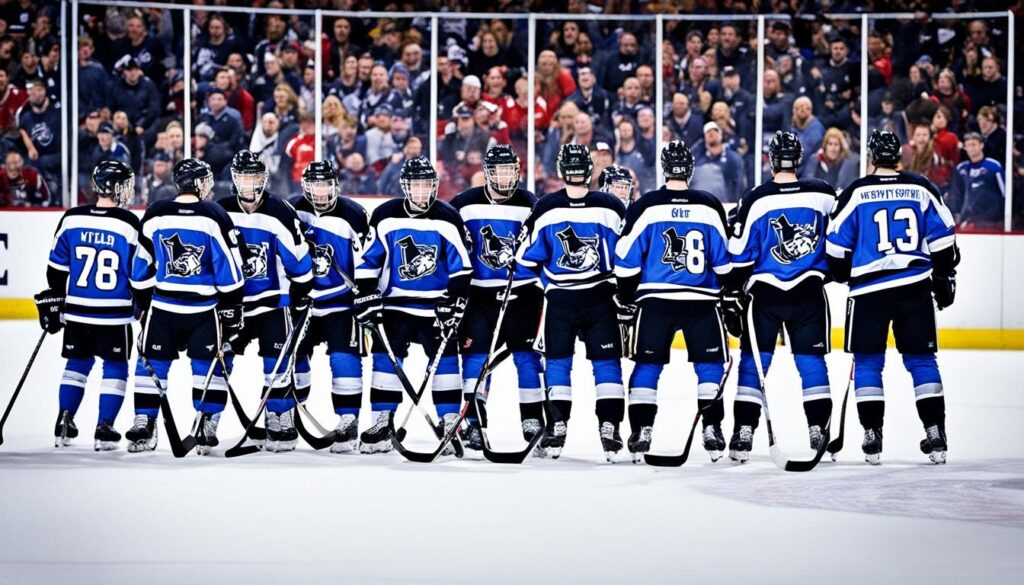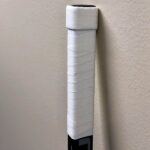A hockey team consists of six players on the ice: three forwards, two defensemen, and one goalie. Teams also have additional players on the bench.
Hockey is a fast-paced, exciting sport played on ice. Each team fields six players, including a goalie, two defensemen, and three forwards. The objective is to score goals by shooting a puck into the opponent’s net. Players use hockey sticks to control, pass, and shoot the puck.
Teams can make substitutions throughout the game, ensuring fresh players are always on the ice. Hockey requires skill, speed, and teamwork. Fans worldwide enjoy its thrilling nature, making it a popular sport in many countries. Whether professional or amateur, hockey remains a beloved pastime for many.
Introduction To Hockey Team Composition
Hockey is a fast-paced and exciting sport. It requires a well-organized team. Each player has a specific role. Knowing the team composition is crucial. It helps understand the dynamics of the game.
Brief History
Hockey has a rich history. It started in the 19th century. It was first played on frozen ponds. The game quickly grew in popularity. Soon, organized leagues were formed. The rules and team structure evolved over time. Today, hockey is played worldwide. It is especially popular in cold countries.
Importance Of Team Structure
A hockey team has six players on the ice. This includes one goalie, two defensemen, and three forwards. Each player has a vital role. The goalie protects the net. The defensemen guard their zone and support the goalie. The forwards focus on scoring goals and creating offensive plays.
| Position | Role |
|---|---|
| Goalie | Protect the net |
| Defensemen | Guard the zone, support goalie |
| Forwards | Score goals, create plays |
A hockey team usually has more than six players. Teams have a roster of up to 20 players. This includes substitutes and reserve players. Substitutes can replace tired or injured players. This keeps the game fast and competitive.
Basic Team Size
Understanding the basic team size in hockey is crucial for fans and players. Hockey is a fast-paced game, and team size impacts strategy and gameplay.
Standard Number Of Players
The standard number of players on a hockey team is usually six per side. This includes:
- One goaltender
- Two defensemen
- Three forwards
Teams can have up to 20 players on the roster, but only six are on the ice during play.
Variations By League
Different leagues have variations in team sizes. Here are some examples:
| League | On-Ice Players | Roster Size |
|---|---|---|
| NHL | 6 | 23 |
| Olympics | 6 | 25 |
| Youth Leagues | 6 | 15-20 |
In some youth leagues, fewer players may be on the ice to focus on skill development.
Player Roles And Positions
Understanding the roles and positions of hockey players is essential. Each player has a specific role that contributes to the team’s success. These roles are divided into three main categories: forwards, defensemen, and goaltenders. Each position has unique responsibilities and requires specific skills.
Forwards
Forwards are primarily responsible for scoring goals. They are divided into three types: centers, left wings, and right wings.
- Centers: Centers play in the middle of the ice. They are responsible for both offense and defense. They take face-offs and often lead attacks.
- Left Wings: Left wings position on the left side of the ice. They focus on scoring goals and assisting the center. They also help in defense.
- Right Wings: Right wings position on the right side. Their role is similar to left wings. They aim to score and assist while also defending.
Defensemen
Defensemen protect their team’s goal from the opponent’s attacks. They are divided into left defensemen and right defensemen.
- Left Defensemen: Left defensemen play on the left side of the ice. They block shots and clear the puck from their zone. They support the forwards in offensive plays.
- Right Defensemen: Right defensemen play on the right side. They perform similar duties to left defensemen. They focus on stopping the opponent’s forwards.
Goaltenders
Goaltenders are the last line of defense. They prevent the puck from entering their team’s net.
- Skills: Goaltenders need quick reflexes and excellent hand-eye coordination. They must anticipate the opponent’s shots and make crucial saves.
- Positioning: Goaltenders position themselves to cover the net. They adjust their stance based on the play’s development.
Each role in a hockey team is crucial. Understanding these roles helps appreciate the game’s complexity and teamwork.

Credit: www.britannica.com
Bench And Substitutes
Understanding the role of the bench and substitutes in hockey is essential for fans and players alike. A well-managed bench can be the difference between victory and defeat. This section will delve into the rules and roles associated with the bench and substitutes in a hockey team.
Substitution Rules
In hockey, teams can make unlimited substitutions. Players rotate frequently to maintain energy and performance. Substitutions can happen during play or during stoppages.
- On-the-fly substitutions: Players change without stopping the game.
- Stoppage substitutions: Changes occur when the referee stops play.
Coaches decide the rotation strategy. They aim to keep players fresh and effective. Players must enter and leave the ice at the designated area. This ensures smooth and fair transitions.
Role Of The Bench
The bench is where players rest and prepare to re-enter the game. It is also the strategic hub for the team. Coaches use the bench to communicate strategies and adjustments.
| Role | Description |
|---|---|
| Rest | Players regain energy and hydrate. |
| Strategy | Coaches discuss tactics and game plans. |
| Injury Management | Medical staff attend to minor injuries. |
The bench is also a place for team support. Players on the bench cheer and motivate those on the ice. This boosts team morale and fosters a strong team spirit.
In summary, the bench and substitutes play crucial roles in hockey. Effective use of the bench can greatly influence a team’s success.
Special Teams
In hockey, special teams play a crucial role during the game. Special teams refer to units specifically designed for situations like power plays and penalty kills. These units come into play when there are penalties and can drastically change the game’s momentum.
Power Play Units
A power play occurs when the opposing team has a player in the penalty box. This gives the team with the advantage an extra player on the ice. Power play units usually consist of the following:
- 2 Defensemen
- 3 Forwards
The goal is to score during the penalty time. The team focuses on puck control and creating scoring opportunities. Key players with strong offensive skills often play in these units.
Penalty Kill Units
A penalty kill happens when a team has a player in the penalty box. This means they are playing with one less player. The goal is to prevent the opposing team from scoring. Penalty kill units generally include:
- 2 Defensemen
- 2 Forwards
These players focus on defense and clearing the puck from their zone. Penalty killers need to be quick and smart. They must read the game and make quick decisions to keep the puck away from their net.
Both power play and penalty kill units are vital. They can change the game’s outcome. Teams practice these scenarios to be ready for any situation.
Junior And Amateur Teams
Junior and amateur hockey teams are the backbone of hockey development. These teams provide young players with opportunities to learn and grow. They also help players prepare for more competitive levels.
Youth Leagues
Youth leagues are where many young players start their hockey journey. These leagues often have players aged between 5 and 18 years old. A typical youth hockey team has 6 players on the ice at any given time. This includes:
- 1 goalie
- 2 defensemen
- 3 forwards
Teams usually have additional players on the bench. This allows for substitutions and rest. The total roster size can vary, but most youth teams have around 15 to 20 players.
College Teams
College hockey teams are more competitive than youth leagues. They feature older and more skilled players. Each college team also has 6 players on the ice during play. The positions are the same:
- 1 goalie
- 2 defensemen
- 3 forwards
College teams generally have larger rosters. This is to ensure depth and cover for injuries. A typical college team roster includes 20 to 25 players. This allows for three to four lines of forwards and three pairs of defensemen.
International And Olympic Teams
Hockey is a global sport enjoyed by millions. The structure of teams can differ, especially in international and Olympic settings. Understanding these differences can enhance your appreciation of the game.
Team Size Regulations
In international and Olympic hockey, team sizes have specific regulations. Each team typically consists of 20 players. This includes:
- 12 forwards
- 6 defensemen
- 2 goalies
The game roster, however, is limited to 18 skaters and 2 goalies. This means that only 20 players can be dressed for the game.
Notable Differences
There are some notable differences between international and domestic hockey teams:
| Aspect | International Teams | Domestic Teams |
|---|---|---|
| Team Size | 20 players | 23 players |
| Game Roster | 18 skaters, 2 goalies | 20 skaters, 3 goalies |
| Regulations | IIHF Rules | League-Specific Rules |
International teams follow the IIHF rules, which can differ from league-specific rules.
The game dynamics can change based on these differences. It is important to know these variations.

Credit: medium.com
Credit: www.quora.com
Conclusion
Understanding the number of players in a hockey team helps deepen your appreciation for the sport. Each team consists of six players on the ice. This includes three forwards, two defensemen, and one goalie. Now you can enjoy watching games with a better grasp of team dynamics.
Happy watching!


